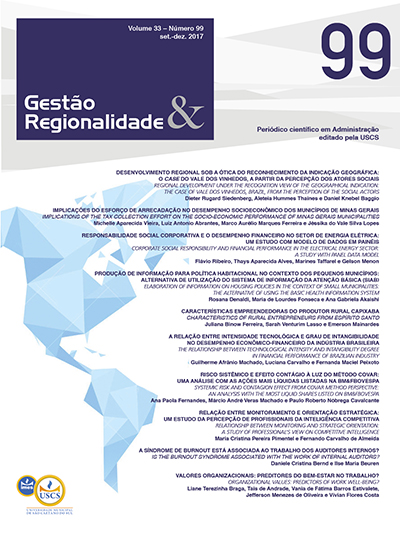IS THE BURNOUT SYNDROME ASSOCIATED WITH THE WORK OF INTERNAL AUDITORS?
DOI:
https://doi.org/10.13037/gr.vol33n99.3408Abstract
The goal of this study is to measure the levels of Burnout faced by the internal auditors in their work environment. This is a descriptive study, conducted through a survey on a sample of 124 professionals of the internal audit area in Brazil. Maslach Burnout Inventory – General Survey (MBI-GS) was the instrument used for data collection, aiming at estimating the levels of incidence of Burnout symptoms. Descriptive statistics, factor analysis, reliability testing, correlations and t test were used in the data analysis. The research results showed the existence of Burnout levels in the dimensions of emotional exhaustion, depersonalization and low personal fulfillment, in low, moderate and high levels, but with a predominance of low levels. It is concluded that there is need for greater care in situations that lead to emotional exhaustion, which showed more tendency to Burnout, in this study, in the internal auditors’ working environment.
Downloads
Downloads
Published
How to Cite
Issue
Section
License
Autores que publicam nesta revista concordam com os seguintes termos:
- Autores mantém os direitos autorais e concedem à revista o direito de primeira publicação, com o trabalho simultaneamente licenciado sob a https://creativecommons.org/
licenses/by-nc-nd/4.0/ , permitindo o compartilhamento do trabalho com reconhecimento da autoria do trabalho e publicação inicial nesta revista. - Autores têm autorização para assumir contratos adicionais separadamente, para distribuição não-exclusiva da versão do trabalho publicada nesta revista (ex.: publicar em repositório institucional ou como capítulo de livro), com reconhecimento de autoria e publicação inicial nesta revista.
- Autores têm permissão e são estimulados a publicar e distribuir seu trabalho online (ex.: em repositórios institucionais ou na sua página pessoal) a qualquer ponto antes ou durante o processo editorial, já que isso pode gerar alterações produtivas, bem como aumentar o impacto e a citação do trabalho publicado (Veja O Efeito do Acesso Livre).
























